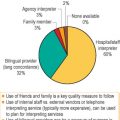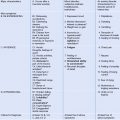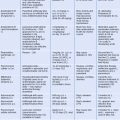CHAPTER 54 School Readiness and Bilingual Education
Introduction
Schools are typically the first setting of sustained contact with the new culture for immigrant children. Their success and performance are often shaped by these very early first experiences. School performance is perhaps more important in the era of ‘No Child Left Behind’ (NCLB) than ever before, and there may be no group for whom this is more important than the children of immigrants. Completing and going beyond high school is critically important to job success today1 and yet some of the highest drop out rates occur among immigrant children. Foreign-born students had a dropout rate of 26% in 2003, compared with 17% for children born in the US to foreign-born parents, both of which are higher than the national average (10.3% in 2004).2 While foreign-born students make up 12% of the total population of high school students, they make up 30% of the dropout population. These numbers may be suspect since many immigrant children never ‘drop in’ to US schools; that is, children who immigrate later in life begin working immediately and never officially enter the US school system.3 Among Latino youth who are educated in US schools, there is no statistically different dropout rate for the immigrants versus the US born; in fact, immigrant children drop out at a rate of 14% versus 18% for US-born Latino youth.4 This is potentially linked to a shifting in family and individual values as adolescents lose the hope for ‘obtaining the American dream’ as the reality of poverty and inequality sink in.
NCLB attempts to address these very issues among immigrant children.5 It attempts to provide for both immigrant children and limited English proficient (LEP) youth. Under NCLB, LEP youth are one of the key groups that must be tested. The law mandates that LEP testing scores must improve over time and that schools be held accountable for their performance. Schools that don’t ‘make this grade’ must offer families other options including transfer to other schools immediately, after-school tutoring, and other supplemental programs. In theory, NCLB will effect change on bilingual and English as a second language (ESL) (sometimes called sheltered English) programs as students in these programs will be held to the same standard as English learners. In addition, teachers in these programs must be highly qualified to teach in their subject. Many believe that in order to succeed in these goals, NCLB must place more emphasis on school readiness among immigrant children, including prekindergarten and the early grades, as well as parental involvement.
Who are These Youth?
The more than two million immigrant youth who enrolled in US public schools over the past decade represent significant challenges for local school systems. Like earlier waves of immigrant students, most are concentrated in a few large cities; they are typically poor; many have suffered the traumas of war, civil strife, or economic deprivation; and all must learn the language and customs of a new country. Recent newcomers hail from a more diverse range of cultures than earlier groups, which were primarily European, and many refer to these as the ‘new immigration’ which intensified in the 1990s. To clarify, when the term ‘immigrant children’ is used, it refers to foreign-born children who have migrated either as immigrants or refugees. ‘Children of immigrants’ on the other hand, refers to both US-born and foreign-born children who share a common denominator: immigrant parents. Among children of immigrants, 25% are foreign-born and 75% are born in the USA. These two groups currently make up 20% of all youth in the US and 25% of all low-income children (family incomes under 200% of the poverty level).6 It is estimated that by 2015 they will make up 30% of the nation’s school population.
Seventy-eight percent of all immigrant students who have been in the United States for 3 years or less attend school in just five states, with 45% enrolled in California.7 As of 1990, 11% of all youth living in California were born outside the United States; the proportions for New York, Florida, Texas, and Illinois range between 6% and 3%. Together, these five states are home to over 1.5 million immigrant youth. In the large city school districts of Los Angeles and Miami, immigrant students represent 20% of the total enrollment.
The Issue of Bilingualism
The overarching challenge for all children of immigrants is the issue of language. The definition of ‘limited English proficient’ (LEP) includes all children who speak a language other than English at home and speak English less than ‘very well.’ The LEP share is highest in kindergarten with 10% of kindergarteners classified as LEP. The proportion of LEP children falls to 6% in the lower grades and 4% in the upper grades.5 In addition, 8 out of 10 LEP children in kindergarten and 6 out of 7 in grades 1–5 are also linguistically isolated – members of families in which all those over 14 are LEP. This challenge is further exacerbated by the fact that over half (53% according to the 1999–2000 Schools and Staffing Survey) of LEP students attend schools where over 30% of their fellow students are LEP.
In learning a second language, most experts agree that the best predictor of success is skill and attained milestones in the first language. A common myth is that native language use at home interferes with the acquisition of a second language at school. In a comprehensive review of bilingualism by the National Research Council, they conclude that ‘the use of the child’s native language does not impede the acquisition of English.’8 Furthermore, they add that the use of a child’s native language in school does not impede the acquisition of English but ‘the key issue is not finding a program that works for all children and all localities but rather finding a set of program components that works for the children in the community of interest.’
There are several types of bilingual and immersion educational models9 including:
Effective Bilingual Schools
In spite of sometimes heated political debate, school systems continue to struggle with how best to educate bilingual children – or oftentimes more specifically, how best to educate English language learners (ELLs), as many school systems refer to children who are LEP students – shifting from a deficit to an asset model. Most research has shown that it takes 4–9 years for ELLs to achieve full proficiency in English.10 As above, schools have utilized a variety of instructional approaches to assist these students to achieve their full potential. There is considerable local variation and interpretation of the above approaches. Hornberger more broadly classifies bilingual education into three types: transitional, maintenance, and enrichment.11 The overriding goal of transitional bilingual education is learner achievement in English as quickly as possible, and thus they are often called ‘early-exit’ bilingual programs. Early-exit programs advocate using the non-English language as a medium of instruction only until the learners are able to function exclusively in English-medium classrooms. The most common medium for delivery of early-exit classrooms is a self-contained classroom taught by a bilingual teacher. In some schools, however, native language instruction is provided by bilingual assistants or resource teachers who remove children from the classroom to instruct them in their native language. Most early-exit programs strive to transition learners out of bilingual education in 3 years or less. The decision of when a child is ready to exit is often based on performance on a standardized test which ranks children’s language abilities in English and the native language as well. Children usually need to reach some minimal level in English before they are transitioned out. Usually, though, this minimal language level is based on understanding and speaking English, and this may not adequately reflect the child’s ability to read and write in English, which often lags behind oral skills and is critical to academic success.
These five types of programs are similarly implemented at both the primary and secondary school levels. What may change is the proficiency level in the native language for older children. That is, a child who enters an English-speaking system in high school may be literate in the native language in most subject areas. A significant challenge exists when children and adolescents arrive illiterate in both their native language and English, making placement and transition a difficult operation – often resulting in the high dropout rate referred to above. School systems dealing with significant numbers of students in this category have devised specific classrooms to address these needs, but in smaller locales where the number of students in this group is lower, students often languish and quickly give up. In general, research has found that it takes 5–7 years for second-language learners who have received at least 2–3 years of schooling in their native language to compete with native speakers.12 Unfortunately most programs do not allow this time.
Stay updated, free articles. Join our Telegram channel

Full access? Get Clinical Tree







